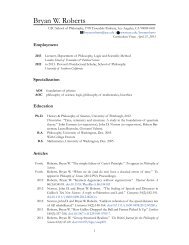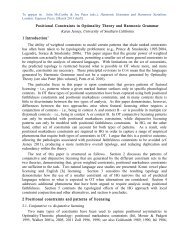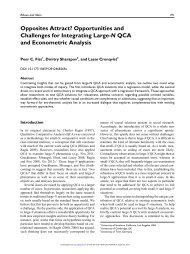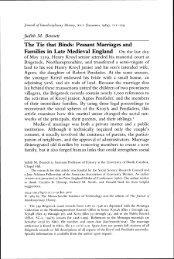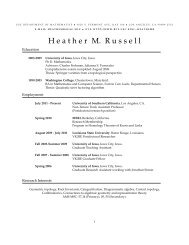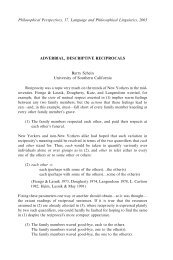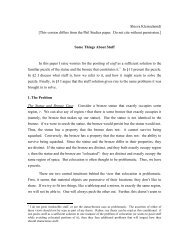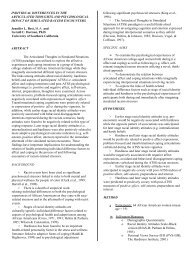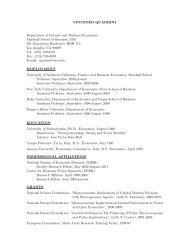women, gender, and medieval historians - Usc
women, gender, and medieval historians - Usc
women, gender, and medieval historians - Usc
You also want an ePaper? Increase the reach of your titles
YUMPU automatically turns print PDFs into web optimized ePapers that Google loves.
chapter 1<br />
<strong>women</strong>, <strong>gender</strong>, <strong>and</strong><br />
<strong>medieval</strong> <strong>historians</strong><br />
Judith M. Bennett <strong>and</strong> Ruth Mazo Karras<br />
Medieval people considered “man” the human st<strong>and</strong>ard <strong>and</strong> “woman” peculiarly capable<br />
of both extraordinary good, as with the Virgin Mary, <strong>and</strong> evil, as exemplified by Eve.<br />
For many centuries after the close of the Middle Ages, <strong>historians</strong> echoed these assumptions,<br />
treating <strong>medieval</strong> <strong>women</strong> as the marked <strong>gender</strong>—as opposed to men whose <strong>gender</strong><br />
went unnoticed—<strong>and</strong> characterizing <strong>women</strong> as both revered (ladies on pedestals)<br />
<strong>and</strong> maligned (witches at the stake). But no longer. Since the 1970s, <strong>historians</strong> of <strong>medieval</strong><br />
<strong>women</strong> have written more often about variety <strong>and</strong> opportunity than pedestals or<br />
stakes, <strong>and</strong> since the 1990s, <strong>gender</strong> <strong>historians</strong> have unpacked the many <strong>gender</strong>s <strong>and</strong> <strong>gender</strong>ed<br />
languages of <strong>medieval</strong> Europe.<br />
Th is volume grows from these new underst<strong>and</strong>ings of <strong>medieval</strong> <strong>women</strong>, men, <strong>and</strong><br />
<strong>gender</strong>. On the one h<strong>and</strong>, the essays collected here continue the ongoing task of creating<br />
fully peopled histories of the Middle Ages, <strong>and</strong> to that end, the volume focuses more on<br />
<strong>women</strong> than men. Some authors highlight <strong>women</strong>’s agency <strong>and</strong> creativity (see chapters<br />
by Fiona Griffiths <strong>and</strong> Anneke Mulder-Bakker). Others focus on how <strong>women</strong>’s lives varied<br />
across social, regional, religious, <strong>and</strong> temporal contexts (see chapters by Elisheva<br />
Baumgarten, Sarah Rees Jones, <strong>and</strong> Martha Howell). Still others argue that <strong>women</strong> were<br />
central actors in the unfolding of <strong>medieval</strong> history (see chapters by Albrecht Diem <strong>and</strong><br />
Constance Berman). On the other h<strong>and</strong>, this volume also explores the many meanings<br />
of <strong>gender</strong> in the Middle Ages. The chapters by Kathryn Ringrose, E. Jane Burns, <strong>and</strong><br />
Helmut Puff evoke a rich history of <strong>medieval</strong> <strong>gender</strong> benders <strong>and</strong> diverse masculinities<br />
<strong>and</strong> femininities. Some <strong>women</strong> seemed manly in their devotion; some men seemed<br />
feminine in their subjection to God; <strong>and</strong> <strong>gender</strong>ed ideas flowed so freely that scholars<br />
can now argue that <strong>medieval</strong> people sometimes made room for three or more <strong>gender</strong>s. 1<br />
Gender shaped the life options of <strong>medieval</strong> <strong>women</strong> <strong>and</strong> men; it also shaped how <strong>medieval</strong><br />
people thought about their world. Gendered language described institutions—<br />
Christians saw their church, for example, as a bride of Christ—shaped views of<br />
nature, often imagined as a sort of goddess, <strong>and</strong> even worked to malign minorities;<br />
oxfordhb-9780199582174-e-001.indd 1<br />
7/30/2013 4:42:29 PM
2 judith m. bennett <strong>and</strong> ruth mazo karras<br />
Christians saw Muslim men as sodomitical <strong>and</strong> Jewish men as effeminate. Gendered<br />
metaphors—God as a father; Mercy as a female; Jesus (or in Jewish mysticism, God) as<br />
a mother—were everywhere in <strong>medieval</strong> Europe. Even biblical stories opened up multiple<br />
possibilities, as discussions of the figures of Mary <strong>and</strong> Martha by Kate Cooper (for<br />
the early Middle Ages) <strong>and</strong> Jennifer Deane (for later) show.<br />
As the editors of this collection, we are acutely aware of the boundaries we set, especially<br />
our focus on the <strong>medieval</strong> west, <strong>and</strong> the gaps that remain, especially our slight<br />
coverage of <strong>medieval</strong> masculinities. We also hope that our new histories will not drown<br />
out the old. The stereotypes of pedestal <strong>and</strong> stake seem hopelessly dichotomous today,<br />
but they contain some truth. Medieval thinkers both respected <strong>and</strong> denigrated <strong>women</strong>;<br />
<strong>women</strong> themselves were both restricted <strong>and</strong> resourceful, as has been true, it seems, in<br />
virtually all human societies. Despite all the flexibilities of <strong>medieval</strong> <strong>gender</strong>s, the pervasive<br />
notion of a God-given hierarchical <strong>gender</strong> binary—“man” as more perfectly<br />
human than “woman”—constrained <strong>medieval</strong> ideas about both sexual difference <strong>and</strong><br />
the agency of <strong>women</strong>. Thus, although Christians, Jews, <strong>and</strong> Muslims disagreed on many<br />
issues, they agreed that “woman” was less than “man,” a necessary but weaker divergence<br />
from the male (human) st<strong>and</strong>ard (see chapters by Dyan Elliott, Jonathan Berkey, Judith<br />
Baskin, <strong>and</strong> Katharine Park). Yes, some extraordinary <strong>medieval</strong> <strong>women</strong> achieved a great<br />
deal—more than even most men—<strong>and</strong> some were even deemed man-like, for better<br />
or worse. But these viragoes had first to transcend their lesser femaleness by virtue of<br />
wealth, privileged birth, personality, or spiritual power. At any given level of <strong>medieval</strong><br />
society <strong>and</strong> in any <strong>medieval</strong> century, a girl—<strong>and</strong> the woman she became—had fewer<br />
choices <strong>and</strong> opportunities than did her brother.<br />
Back Stories<br />
Stories about <strong>women</strong> <strong>and</strong> <strong>gender</strong> helped to create the very idea of the “Middle Ages.”<br />
Some of the earliest stories were remarkably silly yet long-enduring. In the “Renaissance”<br />
(from the fourteenth century in Italy, the sixteenth century farther north), when<br />
Europeans were beginning to construct a <strong>medieval</strong> dark age between the glories of<br />
ancient Rome <strong>and</strong> their own self-perceived glory, they concocted barbaric <strong>gender</strong> customs<br />
for that <strong>medieval</strong> past: aristocratic lords who by right took the maidenheads of<br />
peasant brides; crusaders who clasped hideous chastity belts on their wives; <strong>and</strong> a crossdressed<br />
woman who became pope <strong>and</strong> died in public procession, after going into labor<br />
<strong>and</strong> giving birth. The burden of these myths echoes even today, in brides threatened<br />
with legal violation as in the film Braveheart , in pornographic “reconstructions” of chastity<br />
belts, <strong>and</strong> in a Pope Joan reimagined as a feminist heroine. 2<br />
In early modern Europe, these stories did what cross-cultural comparisons of <strong>women</strong><br />
<strong>and</strong> <strong>gender</strong> have often done: they elevated one civilization <strong>and</strong> denigrated another. It<br />
is no accident that the earliest stories about the “right of the first night” were set not<br />
just in a <strong>medieval</strong> past but also in the wilds of Scotl<strong>and</strong> <strong>and</strong> Irel<strong>and</strong>, or that the story of<br />
oxfordhb-9780199582174-e-001.indd 2<br />
7/30/2013 4:42:29 PM
<strong>women</strong>, <strong>gender</strong>, <strong>and</strong> <strong>medieval</strong> <strong>historians</strong> 3<br />
Pope Joan was gleefully repeated by Protestant critics of Catholicism. These early stories<br />
tell more about the interpretive creation of a maligned “Middle Ages” than about actual<br />
<strong>medieval</strong> <strong>women</strong> <strong>and</strong> <strong>gender</strong>s.<br />
When nineteenth-century European intellectuals settled on a three-part past of<br />
ancient, <strong>medieval</strong>, <strong>and</strong> modern, stories about <strong>women</strong> <strong>and</strong> <strong>gender</strong> remained powerfully<br />
determinative of “<strong>medieval</strong>.” In France, a heated public debate raged for decades<br />
about whether lords had, indeed, once claimed the virginity of serf brides (<strong>and</strong> if so,<br />
the church’s complicity in the practice). In Engl<strong>and</strong>, a gothic revival reimagined the<br />
Middle Ages as a glorious age of unquestioned faith, chivalrous knights, <strong>and</strong> honored<br />
ladies. The Lady of Shalott—celebrated in poetry by Alfred Lord Tennyson (1833) <strong>and</strong><br />
in painting by John William Waterhouse (1888)—epitomized the feminine in Victorian<br />
<strong>medieval</strong>ism: loosely lifted from Arthurian legend, she was young, beautiful, pure, <strong>and</strong><br />
tragic. In the United States, Henry Adams’s Mont-Saint-Michel <strong>and</strong> Chartres (1904),<br />
addressed to his nieces <strong>and</strong> based largely on a reimagination of the Virgin Mary, introduced<br />
Americans to this romantic, touching, <strong>and</strong> forever-lost Middle Ages.<br />
This is not to say that much serious study was given to <strong>medieval</strong> <strong>women</strong> <strong>and</strong> <strong>gender</strong><br />
during the nineteenth century. The first professional <strong>medieval</strong>ists—all men—told stories<br />
about kings <strong>and</strong> state-building, popes <strong>and</strong> religious institutions. They systematically<br />
doubted the authenticity of female authors: they dubbed Dhuoda’s h<strong>and</strong>book the product<br />
of a household priest, Hrosvit of G<strong>and</strong>ersheim’s plays a clever hoax, Hildegard of<br />
Bingen’s writings the work of male secretaries, <strong>and</strong> Heloise’s letters the creation of Peter<br />
Abelard. Medievalists are still undoing this mischief today. 3<br />
By the early twentieth century, however, a few female <strong>medieval</strong>ists had found secure<br />
footing, mostly at <strong>women</strong>’s colleges <strong>and</strong> mostly in technical fields (especially legal <strong>and</strong><br />
economic history) that signaled their non-amateur status. A few, emboldened by the<br />
emerging politics of feminism, began to study <strong>medieval</strong> <strong>women</strong> as a subject in their<br />
own right. Like male <strong>historians</strong> interested in state-building kings <strong>and</strong> reforming popes,<br />
these female <strong>medieval</strong>ists focused on elites <strong>and</strong> told stories that spoke to the aspirations<br />
of their day; they found in the Middle Ages a rough-<strong>and</strong>-ready equality of <strong>women</strong> <strong>and</strong><br />
men. Their foundational studies were full of insight, archival discoveries, <strong>and</strong> admirable<br />
<strong>women</strong>—confident nuns, hard-working wives, <strong>and</strong> intrepid queens.<br />
When feminism waned in the middle decades of the twentieth century, so too did<br />
interest in <strong>medieval</strong> <strong>women</strong> <strong>and</strong> <strong>gender</strong>, <strong>and</strong> the few studies then produced usually<br />
offered more downbeat evaluations. In 1955, Betty B<strong>and</strong>el traced a negative trajectory<br />
for <strong>women</strong>, arguing that a powerful ruler like Æthelflæd of Mercia (r. 911–918) was discussed<br />
matter-of-factly in the tenth century, considered disturbingly man-like by the<br />
twelfth century, <strong>and</strong> trivialized as a troublesome wife soon thereafter. When <strong>medieval</strong><br />
<strong>women</strong>’s history revived in the 1970s, the mid-century gap was so profound that Eileen<br />
Power’s half-century-old essays were repackaged as a new <strong>and</strong> authoritative survey. 4<br />
The 1970s <strong>and</strong> 1980s created the study of <strong>medieval</strong> <strong>women</strong> as a vibrant field. Susan<br />
Mosher Stuard edited an early collection of essays (1976); Shulamith Shahar produced<br />
the first textbook (1981); feminist <strong>medieval</strong>ists started a journal (1986), now the Medieval<br />
Feminist Forum ; <strong>and</strong> the Society for Medieval Feminist Scholarship was established<br />
oxfordhb-9780199582174-e-001.indd 3<br />
7/30/2013 4:42:29 PM
4 judith m. bennett <strong>and</strong> ruth mazo karras<br />
(1992).<br />
5<br />
These were heady decades of fact-finding, when feminist <strong>historians</strong> scoured<br />
archives, accumulated data, <strong>and</strong> crunched numbers, all with an eye to recovering the<br />
lost history of <strong>women</strong>. David Herlihy, often working with Christiane Klapisch-Zuber,<br />
told about <strong>women</strong>’s restricted l<strong>and</strong>-holding, their improved life expectancy after 1000,<br />
their ages at marriage <strong>and</strong> family sizes. 6 His use of quantitative data provided a new evidentiary<br />
base, but the data <strong>and</strong> their meanings, once seemingly so secure <strong>and</strong> transparent,<br />
are now much debated, as Maryanne Kowaleski shows in her chapter. Caroline<br />
Bynum traced how female mystics reshaped Christian spirituality <strong>and</strong> how they <strong>and</strong><br />
others played with <strong>gender</strong> by, for example, imagining Jesus as a maternal figure.<br />
7<br />
S ome<br />
now question the extent of a specifically female spirituality, but Bynum’s pioneering<br />
work encouraged extensive feminist interrogation of the texts <strong>and</strong> artifacts of <strong>medieval</strong><br />
piety, reflected here especially in the chapters by Deane, Miri Rubin, Kathleen Ashley,<br />
<strong>and</strong> Mulder-Bakker. Herlihy <strong>and</strong> Bynum, just two among the scores of feminist <strong>historians</strong><br />
who published in these decades, also lent their substantial credibility—as presidents<br />
of both the Medieval Academy of America <strong>and</strong> the American Historical Association—<br />
to this emerging field.<br />
Some <strong>historians</strong> of <strong>medieval</strong> <strong>women</strong> also began at this time to exp<strong>and</strong> on a narrative<br />
of decline. Among social <strong>historians</strong>, Georges Duby argued that early <strong>medieval</strong> aristocratic<br />
families had been relatively egalitarian, but that this changed from the eleventh<br />
century, when <strong>women</strong>’s options narrowed, thanks to the growing importance of patrimonial<br />
property, primogeniture, <strong>and</strong> public office. Among feminist <strong>historians</strong>, Marion<br />
Facinger (who argued in 1968 that early Capetian queens enjoyed powers later queens<br />
lacked) <strong>and</strong> Jo Ann McNamara <strong>and</strong> Suzanne Wemple (who traced in 1973 the “power of<br />
<strong>women</strong> through the family” in early <strong>medieval</strong> Europe) also saw ever-lessening options<br />
for <strong>medieval</strong> <strong>women</strong>. These narratives accorded well with Joan Kelly’s electrifying thesis<br />
(in 1977) that <strong>women</strong> tended to lose opportunity precisely when male opportunity was<br />
exp<strong>and</strong>ing. 8 Timing the decline earlier than Kelly (who located it in the Renaissance),<br />
<strong>medieval</strong>ists suggested that there might have been no “High” Middle Ages for <strong>women</strong>,<br />
that this triumphal era of religious reform, state-building, universities, <strong>and</strong> cathedrals<br />
was, for <strong>women</strong>, an era of waning opportunity.<br />
This neat chronology is no longer quite so compelling. Duby’s thesis has been substantively<br />
undermined by archival studies, as Joanna Drell’s chapter indicates. The circumstances<br />
of <strong>women</strong> in early <strong>medieval</strong> Europe are now understood as more limited<br />
than McNamara <strong>and</strong> Wemple allowed (chapters by Lisa Bitel, Janet Nelson <strong>and</strong> Alice<br />
Rio, <strong>and</strong> Rachel Stone capture the wide range of these circumstances). Continuities in<br />
<strong>women</strong>’s lives can seem more striking than changes (see, for example, Jane Whittle’s<br />
chapter on rural economies). And <strong>historians</strong> now underst<strong>and</strong> <strong>medieval</strong> <strong>women</strong> as much<br />
fuller participants in the developments that enhanced European life from the eleventh<br />
century (see, for example, the chapters by Griffiths, Berman, <strong>and</strong> Kathryn Reyerson).<br />
But the notion of ever fewer opportunities for <strong>women</strong> remains a quiet backbeat in many<br />
feminist histories; readers will discern it, for example, in Stuard’s discussion of marital<br />
assigns <strong>and</strong> Howell’s treatment of the <strong>gender</strong>ed meanings of mercantile capitalism.<br />
oxfordhb-9780199582174-e-001.indd 4<br />
7/30/2013 4:42:29 PM
<strong>women</strong>, <strong>gender</strong>, <strong>and</strong> <strong>medieval</strong> <strong>historians</strong> 5<br />
By 1993, when the Medieval Academy of America devoted an issue of Speculum to<br />
“Studying Medieval Women: Sex, Gender, Feminism,” the field was securely established. 9<br />
It was also changing rapidly, influenced especially by postmodernism <strong>and</strong> third-wave<br />
feminism. “Women” no longer constituted a secure, transparent category; differences<br />
among <strong>women</strong> took on new importance; gr<strong>and</strong> chronologies seemed newly suspicious;<br />
<strong>historians</strong> more openly acknowledged the interpretative processes that give meaning to<br />
seemingly transparent facts; <strong>and</strong> “<strong>gender</strong>” took center stage. From the 1970s, feminists<br />
had understood biological “sex” as distinct from the social construction of “<strong>gender</strong>.” By<br />
the 1990s, this sex/<strong>gender</strong> distinction was less secure, particularly under the force of the<br />
argument that even biological sex differences were, in fact, socially created—thus, all<br />
“sex” was “<strong>gender</strong>.” 10 Joan Scott’s path-breaking article on “Gender: A Useful Category of<br />
Historical Analysis” (1986) inspired a plethora of studies that delved more deeply than<br />
before into discursive constructions of <strong>gender</strong>s <strong>and</strong> sexualities. 11<br />
This collection shows how much feminist <strong>medieval</strong>ists today draw on—<strong>and</strong> move<br />
beyond—these varied traditions. We strive to juggle both <strong>women</strong>’s history <strong>and</strong> <strong>gender</strong><br />
history. We tussle about the possibility of <strong>women</strong>’s changing status over time—whether<br />
within the Middle Ages or at the junctures of ancient/<strong>medieval</strong> <strong>and</strong> <strong>medieval</strong>/modern.<br />
The essays collected here are most certainly not the fruit of a single methodology, a single<br />
chronological vision, or a single judgment as to <strong>women</strong>’s status, <strong>and</strong> we do not aim<br />
in this introduction to wrestle these many voices into a univocal synthesis. Using the<br />
seven categories into which we have grouped our chapters, we review the ways in which<br />
feminist <strong>medieval</strong>ists are now—armed with new sources, new methods, <strong>and</strong> new questions—rewriting<br />
yet again the many histories of <strong>medieval</strong> <strong>women</strong> <strong>and</strong> <strong>gender</strong>.<br />
Gendered Thinking<br />
Every era has its own beliefs about what constitutes “<strong>women</strong>,” “men,” <strong>and</strong> their proper<br />
interrelationship; in the Middle Ages these assumptions accorded rather more authority<br />
to religion <strong>and</strong> less, for example, to science. Thinking on <strong>gender</strong> was rooted in the<br />
three religions of the time, Christianity, Judaism, <strong>and</strong> Islam; in scientific teachings; <strong>and</strong><br />
in political traditions. Each constituted an authoritative literate discourse, <strong>and</strong> together<br />
they spoke about <strong>women</strong> <strong>and</strong> <strong>gender</strong> in a remarkably coherent chorus. Women were<br />
understood as less than men, female attributes as less good than male ones, <strong>and</strong> <strong>gender</strong><br />
relations as properly characterized by womanly submission <strong>and</strong> manly governance.<br />
Theology had pride of place in these discussions not only because so much <strong>medieval</strong><br />
learning was produced in religious contexts but also because religious inquiry then<br />
included almost all knowledge. For example, natural philosophy, which we today call<br />
science, explained God’s creation, <strong>and</strong> political theory taught how humans should operate<br />
within God’s rules. Gender rules were similarly God-given, <strong>and</strong> the submission of<br />
<strong>women</strong> to men paralleled the submission of all humanity to God.<br />
oxfordhb-9780199582174-e-001.indd 5<br />
7/30/2013 4:42:29 PM
6 judith m. bennett <strong>and</strong> ruth mazo karras<br />
There was much variation <strong>and</strong> change, of course. Elliott shows how Christian teachings<br />
on marriage <strong>and</strong> virginity developed over time, albeit from a core of patristic<br />
texts; Berkey traces the many elements—Arab, Roman, <strong>and</strong> Sassanid contexts, as well<br />
as Qur’anic teachings—that comprised Islamic traditions; <strong>and</strong> Baskin stresses that<br />
restrictions on Jewish <strong>women</strong> were more acute in religious ritual than economic practice.<br />
Scholars once favored hierarchical histories of these three intertwined traditions,<br />
usually telling how Jewish <strong>women</strong> were best off, Muslim <strong>women</strong> least so, <strong>and</strong> Christian<br />
<strong>women</strong> somewhere in between. Now, <strong>historians</strong> more often depict <strong>women</strong> in all three<br />
traditions as swimming against patriarchal tides that varied by time, place, <strong>and</strong> faith.<br />
Many also now see <strong>women</strong> as moving more readily than men across confessional<br />
divides—in market places, childbearing, domestic service, <strong>and</strong>, indeed, even slavery<br />
(see chapters by Baumgarten <strong>and</strong> Sally McKee).<br />
We are only beginning to appreciate how much Latin, Hebrew, <strong>and</strong> Arabic cultures<br />
learned from each other. Thus, for example, whether finding piety in celibacy<br />
(Christians) or marriage (Jews <strong>and</strong> Muslims), theologians in all three traditions constructed<br />
female sexuality as a disruptive <strong>and</strong> polluting worry. Medical theories, as<br />
Katharine Park shows, traveled across these cultures, as each adapted classical texts<br />
(especially Aristotelian ones) in distinctive but similar ways. Medieval misogyny was<br />
not, then, solely a nefarious construct of sexually repressed Christians, nor a mere<br />
offshoot of Christian misogamy (anti-marriage polemic). Denigration of <strong>women</strong><br />
was vicious, powerful, <strong>and</strong> cross-cultural; it was also sometimes little more than a<br />
learned game in which, as Alcuin Blamires has put it, authors could “show off their<br />
literary paces.” 12<br />
Medieval Europe was by no means unusual in assuming male dominance; nor was<br />
it unique in articulating this assumption inconsistently <strong>and</strong> applying it ambivalently.<br />
Medieval thinkers were quite capable of holding, at one <strong>and</strong> the same time, contradictory<br />
ideas about <strong>women</strong> <strong>and</strong> <strong>gender</strong>. This is perhaps nowhere clearer than in political<br />
theory as enacted in coronation rituals, where, as Amalie Foessel shows, rule by <strong>women</strong><br />
was at once intolerable <strong>and</strong> tolerated.<br />
In the fifteenth century, anti-woman discourses were both magnified <strong>and</strong> challenged.<br />
Beliefs about <strong>women</strong> as sorcerers became more prominent, growing alongside a continuing<br />
tradition of learned magic as a male preserve; from this development, among<br />
others, would emerge the witch crazes of early modern Europe (see chapter by Laura<br />
Stokes). As some str<strong>and</strong>s of anti-woman discourse deepened, explicit refutations also<br />
developed. Christine de Pizan initiated in 1405 a debate about the misogynous ideas so<br />
deeply embedded in literature <strong>and</strong> theology, <strong>and</strong> her determined writings mark one origin<br />
of feminist thought in Europe (see chapter by Roberta Krueger).<br />
Learned traditions—articulated mostly by men working in major intellectual institutions—speak<br />
to only some parts of the <strong>gender</strong>ed thinking of <strong>medieval</strong> people.<br />
Imaginative literatures move away from universities, yeshivas, <strong>and</strong> madrasas into the<br />
more lay, albeit still elite, worlds of <strong>medieval</strong> courts <strong>and</strong> townhouses. There, <strong>medieval</strong>ists<br />
now discern considerable pleasure in stories that dwell on <strong>gender</strong> trouble—in<br />
<strong>women</strong> who act like men, men who act like <strong>women</strong>, <strong>and</strong> a wide array of sexual desires.<br />
oxfordhb-9780199582174-e-001.indd 6<br />
7/30/2013 4:42:29 PM
<strong>women</strong>, <strong>gender</strong>, <strong>and</strong> <strong>medieval</strong> <strong>historians</strong> 7<br />
Thomas Aquinas <strong>and</strong> other scholastics prescribed how <strong>women</strong> <strong>and</strong> men should be; the<br />
poems <strong>and</strong> romances produced by Chrétien de Troyes <strong>and</strong> others imagined how <strong>women</strong><br />
<strong>and</strong> men might be. Yes, husb<strong>and</strong>s should govern their wives, just as theologians taught;<br />
yes, it was fun to laugh at tales of disobedient wives, such as Alison in Chaucer’s Miller’s<br />
Tale ; in practice, most people expected wives to behave as competent but lesser partners<br />
to their husb<strong>and</strong>s. As Berkey notes in relation to Islamic practices, the rich were particularly<br />
able to adhere to learned <strong>gender</strong> ideals. Most <strong>medieval</strong> people were poor, very poor.<br />
Ordinary folk certainly imbibed some learned ideas from clergy <strong>and</strong> elites, but they had<br />
their own traditions too, visible rarely, only partially, <strong>and</strong> mostly for the last <strong>medieval</strong><br />
centuries.<br />
Looking Through the Law<br />
Law provides some of the best source material for <strong>medieval</strong> <strong>gender</strong> rules as applied to<br />
ordinary people. Prescriptive law reveals how lawyers, judges, <strong>and</strong> legislators understood<br />
<strong>gender</strong> differences; it broadly echoes the story told in other learned traditions.<br />
Documents of legal practice, such as court records, notarial registers, <strong>and</strong> charters, tell<br />
something else; they provide valuable evidence for the actual lives of humble <strong>women</strong><br />
<strong>and</strong> men. These records of legal process did not mirror social reality, for only certain<br />
matters merited legal attention <strong>and</strong> court procedures determined how those matters<br />
were reported. But for <strong>historians</strong> today, <strong>medieval</strong> law, as both prescribed <strong>and</strong> practiced,<br />
constitutes an exceedingly important source of information about <strong>women</strong> <strong>and</strong><br />
non-elites.<br />
In its own time, <strong>medieval</strong> law also provided durable frameworks, especially with<br />
regard to <strong>women</strong> <strong>and</strong> <strong>gender</strong>. Legal categories regularly differentiated <strong>women</strong> <strong>and</strong><br />
men, thereby solidifying <strong>gender</strong> as a critical determinant of status <strong>and</strong> thus, of identity.<br />
Specific laws about <strong>women</strong>’s legal status <strong>and</strong> participation in court proceedings varied<br />
by jurisdiction, but the terms of the debate proved remarkably consistent across legal<br />
systems <strong>and</strong> across time. Questions of <strong>women</strong>’s rights with regard to the ownership, control,<br />
<strong>and</strong> transmission of property—both l<strong>and</strong>ed <strong>and</strong> liquid—long endured. So, too, did<br />
moral regulation, which in the Middle Ages especially focused around the sexual behaviors<br />
of <strong>women</strong> <strong>and</strong> their implications for family formation <strong>and</strong> inheritance.<br />
Medieval societies had such a bewildering variety of jurisdictions, each with its own<br />
procedures, that it is difficult to compare <strong>gender</strong>ed legal statuses. Roman law remained<br />
crucially important throughout the Middle Ages, not so much as a body of specific<br />
enactments but as a set of procedures <strong>and</strong> a way of thinking about the world. Civic law<br />
drew on it extensively, as did the canon law of the church, <strong>and</strong> as Marie Kelleher’s chapter<br />
suggests, local customs interacted with Roman law to create new ways of thinking<br />
about <strong>women</strong> <strong>and</strong> <strong>gender</strong>. Germanic law (already codified within a Romanized context<br />
by the time the first sources survive) <strong>and</strong> local customary law (at first unwritten, but then<br />
codified) also entered the <strong>medieval</strong> mix, although as Nelson <strong>and</strong> Rio show, the surviving<br />
oxfordhb-9780199582174-e-001.indd 7<br />
7/30/2013 4:42:30 PM
8 judith m. bennett <strong>and</strong> ruth mazo karras<br />
sources for the “barbarian” law codes can be very difficult to interpret. Individual concepts<br />
from these various legal systems, such as the Roman dos (roughly, dowry), were<br />
recast to suit changing socio-economic conditions; as Stone <strong>and</strong> Stuard discuss, these<br />
reinterpretations not only shaped <strong>medieval</strong> family structures but also stimulated economic<br />
development.<br />
Law strictly prescribed <strong>women</strong>’s disability, but practice was often more forgiving.<br />
In late <strong>medieval</strong> Mediterranean towns (which are exceptionally rich in legal records),<br />
<strong>women</strong> negotiated, with or without men’s help, their own legal <strong>and</strong> business affairs (see<br />
chapters by Reyerson <strong>and</strong> Carol Lansing). Even in canon law, a jurisprudence studied<br />
<strong>and</strong> applied across Christian Europe, litigants still had considerable room to maneuver<br />
(as shown in chapters by Kelleher <strong>and</strong> Sara McDougall). Feminist <strong>historians</strong> today look<br />
both at the law—its bewildering uniformity <strong>and</strong> diversity, in both theory <strong>and</strong> practice—<br />
<strong>and</strong> through it to discern what its records might tell about otherwise undocumented<br />
<strong>women</strong> <strong>and</strong> men.<br />
Domestic Lives<br />
Modern English obfuscates the realities of domestic labor in the Middle Ages. “Lady”<br />
suggests a refined femininity far from the authoritative ladies of the <strong>medieval</strong> aristocracy;<br />
“housewife” has lost much of its original, <strong>medieval</strong> emphasis on work; <strong>and</strong> “servant”<br />
evokes the parlor more than the field or workshop. Our underst<strong>and</strong>ings are further<br />
clouded by all-too-ready biological assumptions—that, for example, it was the fate of<br />
<strong>medieval</strong> <strong>women</strong> to produce streams of children in quick succession, or that it was<br />
somehow natural for <strong>women</strong> take on more domestic tasks than men (see critiques in<br />
chapters by Kowaleski, Whittle, <strong>and</strong> Rees Jones).<br />
Historians of the early Middle Ages, working mostly with sparse evidence for the aristocracy,<br />
have built narratives of change—marriage (once multiple <strong>and</strong> weak) becoming<br />
a single, permanent bond, <strong>and</strong> lineage narrowing from bilateral to patrilineal.<br />
McNamara <strong>and</strong> Wemple once characterized this half-millennium as a time of extraordinary<br />
opportunity for elite <strong>women</strong>. Nelson <strong>and</strong> Rio now read law codes as more contingent,<br />
but at the same time less positive for <strong>women</strong>. Stone sees Carolingian <strong>women</strong> as<br />
ideologically more “moral” <strong>and</strong> more “private” than their Merovingian counterparts.<br />
And Drell doubts that the first five hundred years of the Middle Ages did, in fact, produce<br />
a halcyon age for aristocratic <strong>women</strong>.<br />
From 1000, several different general patterns of European domesticity emerge. As<br />
Kowaleski notes, one cuts Europe south <strong>and</strong> north, with <strong>women</strong> in Mediterranean<br />
Europe marrying younger, more often, <strong>and</strong> to older husb<strong>and</strong>s than did <strong>women</strong> in the<br />
north—<strong>and</strong> thus, more likely to be dependent on their husb<strong>and</strong>s at first <strong>and</strong> widowed<br />
later. Another trend cuts Europe by class, with aristocratic <strong>women</strong> throughout Europe<br />
marrying in high numbers <strong>and</strong> at young ages, as Drell shows. Yet another distinction<br />
cuts by religion, for, as Baumgarten argues, Jews throughout Europe tended to marry<br />
oxfordhb-9780199582174-e-001.indd 8<br />
7/30/2013 4:42:30 PM
<strong>women</strong>, <strong>gender</strong>, <strong>and</strong> <strong>medieval</strong> <strong>historians</strong> 9<br />
early <strong>and</strong> universally. To these must be added at least three more domestic situations:<br />
those of never-married single<strong>women</strong>, accounting for as much as one third of adult<br />
<strong>women</strong> in the north; those of nuns; <strong>and</strong> of course, those of widows. Some experiences<br />
transcended these variations; throughout Europe, for example, clerks identified men by<br />
such public characteristics as occupation or rank <strong>and</strong> <strong>women</strong> by family ties. 13<br />
By the later Middle Ages, three themes—middle-class domesticity, <strong>gender</strong>ed space,<br />
<strong>and</strong> domestic piety—loom large. 14 The development of the European middle class, long<br />
a preoccupation of modern <strong>historians</strong>, now seems critical to underst<strong>and</strong>ing late <strong>medieval</strong><br />
domesticity. Wealthy burghers possessed many more things than ever before: better<br />
houses, more furnishings, <strong>and</strong> more fashionable clothes. The management of these<br />
goods, as Katharine French shows in her chapter, quickly became a female responsibility<br />
<strong>and</strong> a source of female agency, <strong>and</strong> as Howell argues, a new bourgeois ideology of <strong>gender</strong><br />
emerged whereby <strong>women</strong> were to be good housewives, busy at home, <strong>and</strong> men were to<br />
be good citizens, busy in public work. 15 Slowly but steadily, in Rees Jones’s view, these<br />
changes spread to other social groups. Once burghers’ wives adopted a new definition<br />
of female honesty rooted in their own domestic roles, the age-old public work of more<br />
humble <strong>women</strong> became newly suspect.<br />
As Rees Jones also stresses, <strong>medieval</strong> spaces did not always divide neatly into public<br />
(masculine) <strong>and</strong> private (feminine). Markets, streets, <strong>and</strong> guildhalls provided common<br />
spaces <strong>and</strong> public spheres; designs of late <strong>medieval</strong> castles, townhouses, <strong>and</strong> cottages<br />
promoted the privatization <strong>and</strong> en<strong>gender</strong>ing of domestic spaces; <strong>and</strong> housewifery, challenged<br />
by the abounding possessions of late <strong>medieval</strong> households, was redefined to better<br />
accommodate to an emerging consumer economy.<br />
Medieval households were also deeply embedded in faith. This was always obvious for<br />
Jewish households (see Baumgarten), but in the 1970s <strong>and</strong> 1980s, the study of <strong>medieval</strong><br />
Christian life focused on the public <strong>and</strong> institutional, <strong>and</strong> the study of female piety was<br />
accordingly a study of nuns. Now, however, nunneries look more domestic, 16 <strong>and</strong> lay<br />
households, as Deane argues, seem holy, equipped with chapels <strong>and</strong> chaplains (if rich),<br />
psalters (if middling), <strong>and</strong> rosaries (if poor). Mulder-Bakker shows how sanctity also<br />
changed, with more wives <strong>and</strong> widows recognized for exceptional holiness in the later<br />
Middle Ages, <strong>and</strong> with more holy <strong>women</strong>, like Catherine of Siena, pursuing their devotions<br />
at home.<br />
L<strong>and</strong>, Labor, Economy<br />
When <strong>medieval</strong> <strong>women</strong>’s history took firm shape in the 1970s <strong>and</strong> 1980s, economic history<br />
was a natural ally, providing a developed feminist historiography buttressed by<br />
Marxist scholarship. From these foundations grew robust investigations of <strong>women</strong>’s<br />
work that revolved around two primary issues. The first focused on clothmaking, urbanization,<br />
<strong>and</strong> a chronology that stretched across the <strong>medieval</strong> millennium. As set out in<br />
David Herlihy’s Opera Muliebria (1990), the cloth industry exemplified how <strong>women</strong>’s<br />
oxfordhb-9780199582174-e-001.indd 9<br />
7/30/2013 4:42:30 PM
10 judith m. bennett <strong>and</strong> ruth mazo karras<br />
work outside the home slowly became less important: cloth was usually made by <strong>women</strong><br />
before 1000, men became more active in clothmaking during the central Middle Ages,<br />
<strong>and</strong> by 1500, men executed all but the craft’s most menial tasks. Herlihy’s core insight—<br />
that <strong>women</strong> <strong>and</strong> clothmaking were critical to the <strong>medieval</strong> economy—remains strong.<br />
Thus, Berman has linked economic growth c .1000 to the spread of wind <strong>and</strong> water<br />
mills, which freed <strong>women</strong> from laborious h<strong>and</strong>-milling <strong>and</strong> sent them into the cloth<br />
industry. 17<br />
The second issue focused on the <strong>medieval</strong>/modern divide, particularly in Engl<strong>and</strong>.<br />
Was there a 150-year “golden age” for working <strong>women</strong> during the labor shortage that followed<br />
the plague of 1347–1349 that was eventually snuffed out by population growth <strong>and</strong><br />
a surge towards capitalism c .1500? This question produced a plethora of new facts <strong>and</strong> a<br />
variety of answers—yes, no, <strong>and</strong> maybe just a little bit. 18 Today, feminist research focuses<br />
less on work <strong>and</strong> more on wealth: <strong>women</strong>’s bodies as wealth; <strong>women</strong> <strong>and</strong> the production<br />
of wealth; <strong>and</strong> <strong>women</strong>’s control of wealth.<br />
Women were, themselves, a sort of wealth, for their reproductive work—both biological<br />
<strong>and</strong> social—was highly valued in <strong>medieval</strong> family economies. Men needed<br />
<strong>women</strong> to produce their heirs <strong>and</strong> run their households (as Whittle <strong>and</strong> Drell explore).<br />
Women were also valued for the wealth they could bring in marriage, whether to plowmen,<br />
knights, merchants, or artisans. 19 Women’s bodies were even assessed <strong>and</strong> sold<br />
more directly: prices for enslaved <strong>women</strong> depended, as McKee shows, on their suitability<br />
for sexual service, <strong>and</strong> prostitution also represented a direct purchase of <strong>women</strong>’s<br />
bodies. 20<br />
Women labored, as did men, in the production of food, goods, <strong>and</strong> services. As<br />
Reyerson <strong>and</strong> Whittle argue, the sexual division of productive labor was clear but highly<br />
flexible. Women worked in fields <strong>and</strong> forests, in markets <strong>and</strong> shops, for themselves <strong>and</strong><br />
for employers. They tended, more than men, to juggle many occupations. They were<br />
especially prominent in poorly remunerated trades—minor food trades, spinning,<br />
small-scale marketing. They worked for wages much lower than those paid to men.<br />
Medieval <strong>women</strong>, in short, worked hard, but they were rarely empowered by their work.<br />
The same could be said for many working men in <strong>medieval</strong> villages <strong>and</strong> towns, but hard,<br />
unrewarding work was especially <strong>women</strong>’s lot.<br />
Medieval <strong>women</strong> were more often carriers of wealth to husb<strong>and</strong>s or children—<br />
wealth in the form of goods, l<strong>and</strong>, or coin—than creators or managers of it. Women<br />
possessed relatively little wealth: <strong>women</strong>’s wages <strong>and</strong> work produced less income, <strong>and</strong><br />
<strong>women</strong> received less from parents, in either gifts or inheritance. Rich or poor, <strong>women</strong><br />
held, at best, about one fifth of all feudal <strong>and</strong> peasant tenures; both proportions fell by<br />
the later Middle Ages (see Drell <strong>and</strong> Whittle, respectively). Women also had less control<br />
over what little they held. Guardians oversaw the assets of unmarried heiresses;<br />
husb<strong>and</strong>s managed dowries, dowers, <strong>and</strong> other properties; <strong>and</strong> many widows enjoyed<br />
only usufruct of conjugal l<strong>and</strong>s. These patterns were not hard rules. Sometimes law or<br />
custom allowed <strong>women</strong> full control of wealth; sometimes rules were circumvented or<br />
ignored; <strong>and</strong> sometimes (especially when husb<strong>and</strong>s were absent) wives directly managed<br />
family assets.<br />
oxfordhb-9780199582174-e-001.indd 10<br />
7/30/2013 4:42:30 PM
<strong>women</strong>, <strong>gender</strong>, <strong>and</strong> <strong>medieval</strong> <strong>historians</strong> 11<br />
Bodies, Pleasures, Desires<br />
Bodies <strong>and</strong> sexualities have always been inextricably linked to <strong>women</strong> <strong>and</strong> <strong>gender</strong>.<br />
Studies of <strong>medieval</strong> sexual behavior exploded after the 1976 publication of the first<br />
volume of Michel Foucault’s History of Sexuality . 21 Foucault discussed sexuality as a<br />
field of discourse rather than a set of behaviors, <strong>and</strong> he argued that “sexuality” did not<br />
really exist before the advent of bourgeois capitalism. Although Foucault tended to<br />
equate male sexuality with human sexuality, his ideas complemented those of feminist<br />
<strong>historians</strong> who argued that it was language <strong>and</strong> culture, rather than nature, that<br />
dictated the reproductive destiny of <strong>women</strong>, the permeability of the female body, <strong>and</strong><br />
beliefs about <strong>gender</strong>. Foucault’s interest in male homosexuality, which he argued did<br />
not exist as an identity before the nineteenth century, also stimulated new research.<br />
John Boswell’s Christianity, Social Tolerance, <strong>and</strong> Homosexuality (1980) argued that<br />
gay identity was as old as the Middle Ages <strong>and</strong> so, too, was tolerance of gay lifestyles.<br />
In the extensive debates that followed, male same-sex relations—whether socially<br />
“constructed” or biologically “essentialist”—briefly became the central category in the<br />
history of <strong>medieval</strong> sexuality. 22<br />
Scholars now question whether “homosexuality” is even a relevant concept in the<br />
Middle Ages. As Puff shows in this volume, <strong>medieval</strong> texts reveal a variety of affectionate<br />
<strong>and</strong> erotic relationships among same-sex couples that do not readily map onto modern<br />
categories. Medieval people seem not to have thought, for example, that sex-of-partner<br />
determined <strong>gender</strong> identity. Dominance was <strong>gender</strong>ed male <strong>and</strong> passivity female.<br />
Thus, in the few extant court cases that treat female same-sex relations before 1500, the<br />
dominant (penetrating) partner is figured as man-like <strong>and</strong> abominable, the other (passive)<br />
partner as woman-like <strong>and</strong> forgivable. 23 Sex without penetration was unimaginable<br />
in <strong>medieval</strong> law, <strong>and</strong> as a result, some sexual practices were ignored, reinterpreted, or<br />
reconfigured as <strong>gender</strong> transgressions.<br />
Sorting out the affectionate from the erotic—or put another way, determining what<br />
kinds of desires <strong>medieval</strong> people felt—has proven difficult. Insofar as <strong>medieval</strong> people<br />
wrote about desire, they mostly wrote about God. Imaginative literature was a bit<br />
more down to earth. Courtly ideals, expressed particularly in love lyrics <strong>and</strong> Arthurian<br />
romances, shaped aristocratic culture <strong>and</strong> practice, <strong>and</strong> they were remarkably playful<br />
about <strong>gender</strong> <strong>and</strong> sex. As Burns shows, men were not always manly, <strong>women</strong> were<br />
not always passive, <strong>and</strong> desire did not always move along a male–female axis. Indeed,<br />
<strong>medieval</strong> bodies seem to have been malleable <strong>and</strong> negotiable. Differences between<br />
male <strong>and</strong> female bodies were certainly an important way of organizing medical knowledge;<br />
as discussed by Park, the male body was taken as st<strong>and</strong>ard, <strong>and</strong> the female body<br />
assessed against it. But the interplay of body <strong>and</strong> <strong>gender</strong> in the Middle Ages was not just<br />
an either/or proposition. The thirteenth-century Roman de Silence explicitly explored<br />
some of the possibilities. Its heroine is born female but raised as a boy <strong>and</strong> later counseled<br />
by both Nature (who urges a return to female identity) <strong>and</strong> Nurture (who argues for<br />
retaining a male identity). Medical writers <strong>and</strong> practitioners often pondered, as Green<br />
oxfordhb-9780199582174-e-001.indd 11<br />
7/30/2013 4:42:30 PM
12 judith m. bennett <strong>and</strong> ruth mazo karras<br />
discusses, the <strong>gender</strong> of “hermaphrodites” <strong>and</strong> their meaning within God’s plan. 24 And<br />
in the Byzantine east, as Ringrose shows, eunuchs adopted a <strong>gender</strong> distinctiveness that<br />
was built on much more than castration alone.<br />
Nevertheless, throughout the Middle Ages, reproduction was understood as the key<br />
purpose of sexual activity. Thus, physicians <strong>and</strong> other medical practitioners tended<br />
to focus their care of <strong>women</strong>, as Green shows in her chapter, on reproductive health.<br />
Across centuries <strong>and</strong> across religious cultures, the care of <strong>women</strong>’s bodies, whether by<br />
female or male practitioners, focused on preserving fertility <strong>and</strong> facilitating childbirth.<br />
En<strong>gender</strong>ing Christian Holiness<br />
In the last thirty years, feminist scholars have transformed the study of <strong>medieval</strong><br />
Christianity. Bynum’s Holy Feast <strong>and</strong> Holy Fast redirected discussions away from theological<br />
<strong>and</strong> ecclesiastical hostility to <strong>women</strong> (<strong>and</strong> even nuns) to emphasize how <strong>women</strong><br />
were able to shape their own Christian faith. The association of <strong>women</strong> with the flesh,<br />
Bynum argued, allowed <strong>women</strong> to identify with the body of Christ, <strong>and</strong> both female <strong>and</strong><br />
male writers produced a dazzling array of positive associations linking the divine <strong>and</strong> the<br />
feminine. Bynum also demonstrated that although only priests could celebrate the Mass,<br />
holy <strong>women</strong> bypassed this male monopoly through their own experiences of Eucharistic<br />
miracles. In the wake of Bynum’s work on the intersection between theology <strong>and</strong> practice,<br />
feminist scholars of <strong>medieval</strong> Christianity began to tell new <strong>and</strong> startling stories.<br />
As a result, <strong>medieval</strong>ists now see the <strong>medieval</strong> church as willing to play with <strong>gender</strong><br />
binaries. God the Father, although a distinctly masculine figure, was not without<br />
tenderness. God the Son was also masculine, but sometimes given nurturing feminine<br />
attributes, as in Bynum’s examination of “Jesus as mother.” The Holy Spirit, often figured<br />
as a dove, was even less tied to one <strong>gender</strong> or the other. The <strong>medieval</strong> church itself—an<br />
institution in which only men were ordained <strong>and</strong> all <strong>women</strong> (even nuns) were laity—<br />
was often cast as a bride, with Christ as bridegroom. The cult of the saints, particularly<br />
veneration of the Virgin Mary, allowed ample room for feminine aspects to enter religious<br />
devotion (as Rubin shows). Mystics, among them many <strong>women</strong>, regularly played<br />
with a wide range of <strong>gender</strong>ed <strong>and</strong> sexual metaphors in their discussions of the divine;<br />
so, too, did bishops <strong>and</strong> other church leaders. 25<br />
Feminist <strong>medieval</strong>ists have also drawn attention to how <strong>medieval</strong> Christians<br />
deployed <strong>women</strong>, <strong>gender</strong>, <strong>and</strong> sexuality to guard the boundaries of their faith. 26 Wome n<br />
<strong>and</strong> <strong>gender</strong> were everywhere in the Christianization of Europe—as proselytizers, as<br />
converts, <strong>and</strong> as sites of anxiety as old faiths overlapped with new (see Bitel’s chapter).<br />
And when the church came to deal with Christians whose faith diverged from orthodox<br />
teachings, especially from the twelfth century on, <strong>gender</strong> was again important. As John<br />
Arnold points out in his chapter, some heretics diverged from the Roman church in<br />
their <strong>gender</strong> rules (allowing, for example, preaching by <strong>women</strong>), <strong>and</strong> sometimes Rome’s<br />
oxfordhb-9780199582174-e-001.indd 12<br />
7/30/2013 4:42:30 PM
<strong>women</strong>, <strong>gender</strong>, <strong>and</strong> <strong>medieval</strong> <strong>historians</strong> 13<br />
classification of acceptable divergence—whether a belief was merely idiosyncratic or<br />
heretical—hinged on <strong>gender</strong> conformity or nonconformity.<br />
Whereas nuns were once the story of <strong>women</strong> in <strong>medieval</strong> Christianity, the ordinary<br />
pieties of Christian households now comm<strong>and</strong> more attention, as also do lay<strong>women</strong><br />
who pursued holiness outside formal communities. Nuns remain, however, an important<br />
part of our underst<strong>and</strong>ings of <strong>medieval</strong> society. Some scholars have proposed that<br />
nuns (<strong>and</strong> monks as well) became de-<strong>gender</strong>ed by their vows, released from ordinary<br />
st<strong>and</strong>ards; others have argued that while monastics used <strong>gender</strong>ed metaphors flexibly,<br />
they still clung to an overarching binary of <strong>gender</strong>. Regardless, most agree that the lives<br />
of nuns <strong>and</strong> monks were more similar than different (<strong>and</strong> thereby different from most<br />
laity). Diem argues that the forms of monasticism that dominated by the central Middle<br />
Ages may have been originally designed for <strong>women</strong>, <strong>and</strong> in the great monastic reforms<br />
of the twelfth century, as Griffiths shows, <strong>women</strong> worked as hard as men to create new<br />
types of religious practice, even if the eventual results were not entirely positive for them.<br />
Finally <strong>and</strong> most dramatically, female piety today takes center stage in histories of <strong>medieval</strong><br />
spirituality: the theology of Hildegard of Bingen, the heterodoxy of Marguerite Porete,<br />
the mysticism of Catherine of Siena, the eremiticism of Julian of Norwich, the striving<br />
holiness of Margery Kempe, <strong>and</strong> the quotidian devotion of countless ordinary <strong>women</strong>. By<br />
their own h<strong>and</strong> or through scribes, pious <strong>women</strong> wrote extensively about their devotions,<br />
visions, <strong>and</strong> theological insights. Men produced more texts, to be sure, but <strong>women</strong>’s texts<br />
were often distinctively innovative (Kempe’s book is, for example, the first autobiography in<br />
English), <strong>and</strong> female authors likely lie hidden behind a plethora of “anonymous” writings. 27<br />
Forceful pious <strong>women</strong>, Mulder-Bakker demonstrates, also took leadership roles in many<br />
quasi-organized forms of lay piety. Some created or commissioned artworks of extraordinary<br />
power. 28 And everyday <strong>women</strong>—ordinary <strong>women</strong>, not writers, leaders, or artists—<br />
worshipped in homes <strong>and</strong> parishes where, like men, they drew on a range of Christian<br />
practices <strong>and</strong> artifacts that spoke not only to their humanity but also to their <strong>gender</strong> (see<br />
Deane <strong>and</strong> Ashley). There was, in short, far more flexibility <strong>and</strong> space for <strong>women</strong> within<br />
<strong>medieval</strong> Christianity than <strong>historians</strong> once imagined. In this research area, perhaps more<br />
than any other, feminist histories today speak more of opportunity <strong>and</strong> less of constraint.<br />
Turning Points <strong>and</strong> Places<br />
Joan Kelly long ago called on <strong>historians</strong> to <strong>gender</strong> our master narratives, but <strong>medieval</strong>ists<br />
still usually identify epochal change with major events that have little to do with<br />
<strong>women</strong> or <strong>gender</strong>: the deposition of the last Western Roman emperor in 476; the plagues<br />
of 1347–1349; the Ottoman capture of Constantinople in 1453; the voyage of Columbus<br />
in 1492. Even in the 1990s, <strong>gender</strong> remained a glaringly overlooked category in a wellfunded,<br />
international research project on the transformation of the Roman world into a<br />
<strong>medieval</strong> one.<br />
29<br />
More recently, feminist <strong>historians</strong> have suggested downplaying epochal<br />
change altogether—that is, focusing more on continuities. Working, as did Kelly, on the<br />
oxfordhb-9780199582174-e-001.indd 13<br />
7/30/2013 4:42:30 PM
14 judith m. bennett <strong>and</strong> ruth mazo karras<br />
transition from <strong>medieval</strong> to modern, Judith Bennett has argued that while <strong>women</strong>’s work<br />
changed, the status of that work did not: whenever a particular type of work became<br />
more prestigious, as with weaving or brewing, men took it over, <strong>and</strong> tasks identified as<br />
female remained just as low status, low-skilled, <strong>and</strong> poorly compensated as before. 30<br />
Today, feminist chronologies of the Middle Ages work within <strong>and</strong> around these<br />
debates. Historians are finally beginning to look at “late antiquity” with a focus less<br />
on geopolitical events <strong>and</strong> more on the way Christians, particularly Christian <strong>women</strong>,<br />
preserved <strong>and</strong> reconfigured aspects of Roman culture (see Cooper). We are also reassessing<br />
the all-important transitions that cluster around the year 1000. Some, like<br />
McNamara, find a wholesale reorientation of the <strong>gender</strong> system after 1000, as a newly<br />
celibate clergy excluded <strong>women</strong> from ecclesiastical <strong>and</strong> dynastic roles. 31 Others, like<br />
Berman in this volume, see this as a time of exp<strong>and</strong>ing opportunity for <strong>women</strong> <strong>and</strong>,<br />
indeed, even exp<strong>and</strong>ing female influence over the course of historical change. In both<br />
cases, stories of <strong>women</strong> <strong>and</strong> <strong>gender</strong> in the central Middle Ages play against a less glorious<br />
background than was once the case. The same western Europeans who built states,<br />
cathedrals, <strong>and</strong> universities between 1000 <strong>and</strong> 1300 also mounted crusades against<br />
Muslims, persecuted Jews, <strong>and</strong> grew increasingly anxious about sexual minorities.<br />
The transitions of the fourteenth <strong>and</strong> fifteenth centuries are similarly now seen in<br />
ambivalent light. Some changes seem clearly negative: the retrenchment of some <strong>women</strong>’s<br />
economic role as a result of the rise of mercantile capitalism (discussed by Howell) <strong>and</strong> the<br />
beginnings of witch-hunts (discussed by Stokes). Other changes—such as the first glimmerings<br />
of female advocacy in Europe (see Krueger)—are considerably more positive.<br />
As reflected in the essays in this volume, feminist scholarship on the Middle Ages is at<br />
once scholarly <strong>and</strong> political. Feminist <strong>medieval</strong>ists approach the artifacts of the past—<br />
the documents, texts, bones, <strong>and</strong> goods the dead have left for us—with academic rigor<br />
<strong>and</strong> honesty, striving to “get it right.” But we also talk back to sources—asking questions<br />
<strong>and</strong> seeking answers that reflect current issues, both scholarly debates (did <strong>women</strong>’s work<br />
status decline during the Middle Ages?) <strong>and</strong> broadly social concerns (should <strong>women</strong> be<br />
paid equally with men?). The extremes of Mary <strong>and</strong> Eve, of achievement <strong>and</strong> abasement,<br />
can no longer encompass this complex field. Yet the dichotomy speaks to a sort of truth.<br />
Medieval <strong>women</strong> worked hard, created much, <strong>and</strong> accomplished a great deal, but their<br />
achievements are all the more remarkable because they took place within a confined context—a<br />
<strong>medieval</strong> world in which men were human <strong>and</strong> <strong>women</strong> were different.<br />
Further Reading<br />
The contributors to the volume introduced by this essay have produced remarkable<br />
summations of specific areas of research. In addition, see these general resources:<br />
Amt , Emilie , ed. Women’s Lives in Medieval Europe: A Sourcebook . New York : Routledge , 1993 .<br />
Feminae: Medieval Women <strong>and</strong> Gender Index. The University of Iowa Libraries, < http://<br />
inpress.lib.uiowa.edu/feminae/Default.aspx >.<br />
oxfordhb-9780199582174-e-001.indd 14<br />
7/30/2013 4:42:30 PM
<strong>women</strong>, <strong>gender</strong>, <strong>and</strong> <strong>medieval</strong> <strong>historians</strong> 15<br />
Larrington , Carolyne , ed. Women <strong>and</strong> Writing in Medieval Europe: A Sourcebook .<br />
London : New York: Routledge , 1995.<br />
McCarthy , Conor , ed. Love, Sex <strong>and</strong> Marriage in the Middle Ages: A Sourcebook .<br />
London : Routledge , 2004 .<br />
Murray , Jacqueline , ed. Love, Marriage, <strong>and</strong> Family in the Middle Ages: A Reader . Peterborough,<br />
Ont. : Broadview Press , 2001 .<br />
Schaus , Margaret , ed. Women <strong>and</strong> Gender in Medieval Europe : An Encyclopedia .<br />
New York : Routledge , 2006 .<br />
Skinner , Patricia <strong>and</strong> Elisabeth Van Houts , Medieval Writings on Secular Women .<br />
London : Penguin , 2011 .<br />
Wilson , Katharina M. , ed. Medieval Women Writers . Athens, Ga. : University of Georgia<br />
Press , 1984 .<br />
Wilson , Katharina M. <strong>and</strong> Nadia Margolis , eds. Women in the Middle Ages: An Encyclopedia .<br />
Westport, Conn. : Greenwood Press , 2004 .<br />
N o t e s<br />
1 . R. N. Swanson , “ Angels Incarnate: Clergy <strong>and</strong> Masculinity from Gregorian Reform<br />
to Reformation ,” in D. M. Hadley , ed., Masculinity in Medieval Europe (London;<br />
New York : Longman , 1999 ), 160–77 ; Jacqueline Murray , “One Flesh, Two Sexes, Three<br />
Genders ?” in Lisa M. Bitel <strong>and</strong> Felice Lifshitz , eds, Gender <strong>and</strong> Christianity in Medieval<br />
Europe ( Philadelphia : University of Pennsylvania Press , 2008 ), 34–51 .<br />
2 . A l ai n B ou re au , Th e Lord’s First Night: The Myth of the Droit de Cuissage , trans. Lydia<br />
G. Cochrane ( Chicago : University of Chicago Press , 1998 ) ; idem, Th e Myth of Pope<br />
Joan , trans. Lydia G. Cochrane ( Chicago : University of Chicago Press , 2001 ) . Albrecht<br />
Classen , Th e Medieval Chastity Belt: A Myth-Making Process ( New York : Palgrave<br />
Macmillan , 2007 ) .<br />
3 . Barbara Newman , “ Authority, Authenticity, <strong>and</strong> the Repression of Heloise ,” in<br />
From Virile Woman to WomanChrist: Studies in Medieval Religion <strong>and</strong> Literature<br />
( Philadelphia : University of Pennsylvania Press , 1995), 46–75 .<br />
4 . B ett y B <strong>and</strong> el , “ The English Chroniclers’ Attitude Toward Women ,” Journal of the History of<br />
Ideas , 16 ( 1 ) ( 1955 ): 113–18 . Eileen Power , Medieval Women , ed. M. M. Postan ( Cambridge;<br />
New York : Cambridge University Press , 1975 ) .<br />
5 . Susan Mosher Stuard , ed., Women in Medieval Society ( Philadelphia : University of<br />
Pennsylvania Press , 1976 ) ; Shulamith Shahar , The Fourth Estate: A History of Women in the<br />
Middle Ages (London : Methuen , 1983 ) .<br />
6 . D av i d He rl i hy <strong>and</strong> C h r ist i ane K l apis ch-Zub er , Tuscans <strong>and</strong> Their Families: A Study of the<br />
Florentine Catasto of 1427 ( New Haven : Yale University Press , 1985 ) ; Herlihy , Medieval<br />
Households (Cambridge, Mass. : Harvard University Press , 1985 ) ; idem, “L<strong>and</strong>, Family <strong>and</strong><br />
Women in Continental Europe, 701–1200 ,” Traditio , 18 ( 1962 ): 89–120 .<br />
7 . Caroline Walker Bynum , Jesus as Mother: Studies in the Spirituality of the High Middle<br />
Ages (Berkeley : University of California Press , 1982 ) ; idem, Holy Feast <strong>and</strong> Holy Fast: The<br />
Religious Significance of Food to Medieval Women (Berkeley : University of California<br />
Press , 1987 ) .<br />
8 . G e orge s D uby , The Knight, the Lady, <strong>and</strong> the Priest: The Making of Modern Marriage in<br />
Medieval France , trans. Barbara Bray ( New York : Pantheon Books , 1983 ) ; Marion F.<br />
Facinger , “ A Study of Medieval Queenship: Capetian France, 987–1237 ,” Studies in<br />
oxfordhb-9780199582174-e-001.indd 15<br />
7/30/2013 4:42:30 PM
16 judith m. bennett <strong>and</strong> ruth mazo karras<br />
Medieval <strong>and</strong> Renaissance History , 5 (1968 ): 3–48 ; Jo Ann McNamara <strong>and</strong> Suzanne Wemple ,<br />
“ The Power of Women Through the Family in Medieval Europe: 500–1100 ,” Feminist<br />
Studies , 1 (3/4) (1973 ): 126–41 ; Joan Kelly-Gadol , “Did Women Have a Renaissance ?” in<br />
Renate Bridenthal <strong>and</strong> Claudia Koontz , eds, Becoming Visible: Women in European History<br />
(Boston : Houghton Mifflin , 1977 ) , reprinted in Joan Kelly , Women, History, <strong>and</strong> Theory: The<br />
Essays of Joan Kelly (Chicago : University of Chicago Press , 1984 ) .<br />
9 . Speculum , 68 (2 ) (1993 ) ; Nancy F. Partner , ed., Studying Medieval Women: Sex, Gender,<br />
Feminism (Cambridge, Mass. : Medieval Academy of America , 1993 ) .<br />
1 0 . Judit h But l e r , Gender Trouble: Feminism <strong>and</strong> the Subversion of Identity<br />
( New York : Routledge , 1990 ) .<br />
11 . Joan W. Scott , “Gender: A Useful Category of Historical Analysis ,” American<br />
Historical Review , 91 (5 ) (1986 ): 1053–75 ; reprinted in Gender <strong>and</strong> the Politics of History<br />
(New York : Columbia University Press , 1988 ) . Dyan Elliott , “The Three Ages of Joan Scott ,”<br />
American Historical Review , 113 (5) (December 2008 ): 1390–403 .<br />
12 . Alcuin Blamires , ed., Woman Defamed <strong>and</strong> Woman Defended: An Anthology of Medieval<br />
Texts ( Oxford : Clarendon Press , 1992 ), 12 .<br />
13 . For exceptions, see Shennan Hutton , Women <strong>and</strong> Economic Activities in Late Medieval<br />
Ghent ( New York : Palgrave Macmillan , 2011 ) <strong>and</strong> Ellen E. Kittell , “ The Construction of<br />
Women’s Social Identity in Medieval Douai: Evidence from Identifying Epithets ,” Journal<br />
of Medieval History , 25 ( 3 ) ( 1999 ): 215–27 .<br />
1 4 . Mar y an ne Kow a l e sk i <strong>and</strong> P. J. P. G oldb erg , e ds, Medieval Domesticity: Home, Housing<br />
<strong>and</strong> Household in Medieval Engl<strong>and</strong> ( Cambridge; New York : Cambridge University<br />
Press , 2008 ) .<br />
15 . Felicity Riddy , “ Mother Knows Best: Reading Social Change in a Courtesy Text ,” Speculum ,<br />
71 (1 ) (1996 ): 66–86 .<br />
16 . Marilyn Oliva , “Nuns at Home: The Domesticity of Sacred Space ,” in Kowaleski <strong>and</strong><br />
Goldberg , eds, Medieval Domesticity .<br />
1 7 . D av i d He r l i hy , Opera Muliebria: Women <strong>and</strong> Work in Medieval Europe ( Philadelphia :<br />
Temple University Press , 1990 ) ; Constance H. Berman , “ Women’s Work in Family,<br />
Village, <strong>and</strong> Town after 1000 CE: Contributions to Economic Growth ?” Journal of<br />
Women’s History , 19 ( 2007 ): 10–32 .<br />
1 8 . P. J. P. G ol db e rg , Women, Work, <strong>and</strong> Life Cycle in a Medieval Economy: Women in York <strong>and</strong><br />
Yorkshire, c. 1300–1520 (Oxford : Clarendon Press , 1992 ) ; Caroline M. Barron , “The ‘Golden<br />
Age’ of Women in Medieval London ,” Reading Medieval Studies , 15 ( 1989 ): 35–58 ; Marjorie<br />
Keniston McIntosh , Working Women in English Society, 1300–1620 ( Cambridge : Cambridge<br />
University Press , 2005 ) ; Judith M. Bennett , chapter 5 in History Matters: Patriarchy <strong>and</strong> the<br />
Challenge of Feminism ( Philadelphia : University of Pennsylvania Press , 2006 ), 82–107 .<br />
19 . B ar b ar a Hanaw a lt , The Wealth of Wives: Women, Law, <strong>and</strong> Economy in Late Medieval<br />
London (New York : Oxford University Press , 2007 ) .<br />
20 . Ruth Mazo Karras , Common Women: Prostitution <strong>and</strong> Sexuality in Medieval Engl<strong>and</strong><br />
(New York : Oxford University Press , 1996 ) .<br />
2 1 . Ver n L . Bu l l ou g h , Sex, Society, <strong>and</strong> History (New York : Science History Publications , 1976 ) ;<br />
Mi chel Fou c au lt , Histoire de la sexualité ( Paris : Gallimard , 1976 ) , translated as The History<br />
of Sexuality: An Introduction , vol. 1, trans. Robert Hurley (New York : Vintage Books , 1990 ) .<br />
22 . John Boswell , Christianity, Social Tolerance, <strong>and</strong> Homosexuality: Gay People in Western<br />
Europe from the Beginning of the Christian Era to the Fourteenth Century (Chicago;<br />
London : University of Chicago Press , 1980 ) ; debate summarized in Ruth Mazo Karras ,<br />
oxfordhb-9780199582174-e-001.indd 16<br />
7/30/2013 4:42:30 PM
<strong>women</strong>, <strong>gender</strong>, <strong>and</strong> <strong>medieval</strong> <strong>historians</strong> 17<br />
Sexuality in Medieval Europe: Doing Unto Others , 2nd edn ( Abingdon : Routledge ,<br />
2012 ), 5–10 .<br />
23 . James A. Schultz , Courtly Love, the Love of Courtliness, <strong>and</strong> the History of Sexuality<br />
(Chicago : University of Chicago Press , 2006 ) ; Karma Lochrie , Heterosyncrasies: Female<br />
Sexuality When Normal Wasn’t (Minneapolis : University of Minnesota Press , 2005 ) ;<br />
Kar ras , Sexuality in Medieval Europe ; Helmut Puff , “ Female Sodomy: The Trial of<br />
Katherina Hetzeldorfer (1477) ,” Journal of Medieval <strong>and</strong> Early Modern Studies , 30 (1 )<br />
(2000 ): 41–61 ; Jacqueline Murray , “Twice Marginal <strong>and</strong> Twice Invisible: Lesbians in the<br />
Middle Ages ,” in Vern L. Bullough <strong>and</strong> James A. Brundage , eds, H<strong>and</strong>book of Medieval<br />
Sexuality (New York : Garl<strong>and</strong> , 1996 ), 191–223 .<br />
24 . Joan Cadden , Meanings of Sex Difference in the Middle Ages: Medicine, Science, <strong>and</strong><br />
Culture (Cambridge; New York : Cambridge University Press , 1993 ) ; Lorraine Daston <strong>and</strong><br />
Katharine Park , “The Hermaphrodite <strong>and</strong> the Orders of Nature: Sexual Ambiguity in Early<br />
Modern France ,” in Louise Fradenburg <strong>and</strong> Carla Freccero , eds, Premodern Sexualities<br />
( New York : Routledge , 1996 ) ; Leah DeVun , “ The Jesus Hermaphrodite: Science <strong>and</strong> Sex<br />
Difference in Premodern Europe ,” Journal of the History of Ideas , 69 ( 2 ) ( 2008 ): 193–218 .<br />
2 5 . B ar b ar a Ne w man , God <strong>and</strong> the Goddesses: Vision, Poetry, <strong>and</strong> Belief in the Middle Ages<br />
( Philadelphia : University of Pennsylvania Press , 2003 ) .<br />
26 . David Nirenberg , “ Conversion, Sex, <strong>and</strong> Segregation: Jews <strong>and</strong> Christians in Medieval<br />
Spain ,” American Historical Review , 107 (4 ) (2002 ): 1065–93 .<br />
27 . Janet L. Nelson , “Gender <strong>and</strong> Genre in Women Historians of the Early Middle Ages ,” in<br />
The Frankish World, 750–900 ( London : Hambledon , 1996 ) .<br />
2 8 . Jeff rey F. Hamburger , Nuns as Artists: The Visual Culture of a Medieval Convent<br />
(Berkeley : University of California Press , 1997 ) .<br />
29 . Julia M. H. Smith , “Did Women Have a Transformation of the Roman World ?” Gender &<br />
History , 12 ( 3 ) ( 2000 ): 552–71 .<br />
30 . B e n ne tt , History Matters .<br />
31 . Jo Ann McNamara , “The Herrenfrage: The Restructuring of the Gender System, 1050–<br />
1150 ,” in Clare A. Lees , ed., Medieval Masculinities: Regarding Men in the Middle Ages<br />
(Minneapolis : University of Minnesota Press , 1994 ), 3–29 .<br />
oxfordhb-9780199582174-e-001.indd 17<br />
7/30/2013 4:42:30 PM
oxfordhb-9780199582174-e-001.indd 18<br />
7/30/2013 4:42:30 PM



